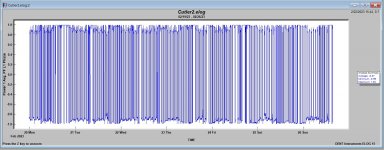Co-worker has been complaining that the lights in his newly built house keep flickering. He has had the utility company out there, 3 or 4 electricians, and has asked us EEs in the office what could cause it. Utility company connected him to a new transformer, New ground rod and grounding electrode conductor because they were connected to rebar in concrete. Our boss (retired) went out there and connected his log meter to the line side conductors and came back with this on Leg 1. He has a negative power factor.
Any thoughts as to what could cause this? We have been going around with different theories for him, but I not had a chance to look at the system, but everyone else has been out there, so I would assume they know a lot so far, but know one has a clue.

Any thoughts as to what could cause this? We have been going around with different theories for him, but I not had a chance to look at the system, but everyone else has been out there, so I would assume they know a lot so far, but know one has a clue.



![Capture1[7].JPG Capture1[7].JPG](https://forums.mikeholt.com/data/attachments/27/27968-280853cc9b54d2e95c3b62aad5c87dab.jpg)